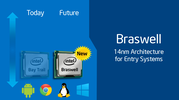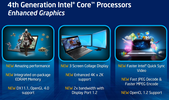Intel HD Graphics 400 (Braswell) vs Intel HD Graphics 5300 vs Intel HD Graphics (Haswell)
Intel HD Graphics 400 (Braswell) ► remove from comparison
The Intel HD Graphics 400 (Braswell) is an integrated graphics card in the low end SoCs of the Braswell series (2016 Celeron models). It is based on the same architecture as the integrated GPU of the Broadwell graphics cards (e.g. HD Graphics 5300 ), but offers less shader cores and slower clock speeds.
It is a rename from the Intel HD Graphics (Braswell) card that included the faster 16 EU model in the Pentium SoCs. See the Intel HD Graphics Braswell graphics card page for benchmarks .
The performance depends on the processor (different boost speed for the GPU) and the used memory.
Gaming performance ist still only suited for older or less demanding games. Often also the processor is limited gaming performance (e.g. in the dual-core N3000).
The SoC also integrates a video decoding engine that should be able to handle 4K H.265 videos.
Intel HD Graphics 5300 ► remove from comparison
The Intel HD Graphics 5300 (GT2) is an integrated Broadwell graphics card revealed in late 2014. It can be found in Core M ULV SoCs such as the Core M-5Y70 . While the GPU shines with its extremely low power consumption, raw performance is quite low and barely sufficient for modern games.
Architecture and Features
Broadwell features a GPU based on the Intel Gen8 architecture, which has been optimized in various aspects compared to the previous Gen7.5 (Haswell). Inter alia, the shader arrays called "subslice" have been reorganized and now offer 8 Execution Units (EUs) each. Three subslices form a "slice" for a total of 24 EUs. Combined with other improvements such as larger L1 caches and an optimized frontend, the integrated GPU has become faster and more efficient than its predecessor.
The HD Graphics 5300 represents the mid-range version of the Broadwell GPU family and consists of one slice with 24 EUs. Beyond that, there is also a low-end variant (GT1, 12 EUs) as well as higher-end models (GT3/GT3e + eDRAM, 48 EUs).
All Broadwell GPUs support OpenCL 2.0 and DirectX 11.2. The video engine can now decode H.265 using both fixed function hardware as well as available GPU shaders. Up to three displays can be connected via DP 1.2/eDP 1.3 (max. 3840 x 2160 @ 60 Hz) or HDMI 1.4a (max. 3840 x 2160 @ 24 Hz). HDMI 2.0, however, is not supported.
Performance
Depending on the specific CPU, the maximum GPU frequency varies between 800 and 900 MHz. Due to the very low TDP, however, the average clock in 3D applications will be significantly lower. Therefore, the HD 5300 just barely outperforms the old HD 4000 or HD 4200 , but requires much less energy for the same performance.
Only a few games as of 2014/2015 will run fluently at low settings, e.g. Dota 2 or Sims 4.
Power Consumption
Thanks to a new 14 nm process, the entire Core M chip is specified at just 4.5 W TDP and is suited for passively cooled tablets. The TDP is flexible and can be reduced or increased, which has a significant impact on performance.
Intel HD Graphics (Haswell) ► remove from comparison
The Intel HD Graphics (Haswell) is an integrated graphics card in the Haswell codenamed processors (Celeron and Pentium). It is the successor the the Intel HD Graphics in the Ivy Bridge CPUs and performs slightly better. Depending on the processor model, the base and turbo clock rates may differ, resulting in varying graphics performance between CPU models.
In comparison to the HD 4000, the graphics core has been modified extensively. The GPU supports DirectX 11.1, OpenCL 1.2 and OpenGL 4.0. It also features an improved decoder for 4K videos and the fast Quick Sync encoder (deactivated in many entry level models).
The Performance of the HD Graphics (Haswell) is similar to the old HD Graphics 3000 or the AMD Radeon HD 8250 . Only a few modern games like Dota 2 can be played fluently in very low details and resolutions.
Due to the 22nm 3D Tri-Gate production process, the power consumption should be relatively low (the development was focused on performance per Watt). The GPU can be found in ULV models and regular (37 W) dual core CPUs.
Intel HD Graphics 400 (Braswell) Intel HD Graphics 5300 Intel HD Graphics (Haswell) HD Graphics Series Codename Braswell Broadwell GT2 Haswell GT1 Architecture Gen. 8 Gen. 8 Broadwell Gen. 7.5 Haswell Pipelines 12 - unified 24 - unified 10 - unified Core Speed 320 - 640 (Boost) MHz 100 - 900 (Boost) MHz 200 - 1000 (Boost) MHz Memory Bus Width 64/128 Bit 64/128 Bit 64/128 Bit Shared Memory yes yes yes API DirectX 11.2, Shader 5.0 DirectX 12 (FL 11_1), OpenGL 4.3 DirectX 11.1, Shader 5.0 technology 14 nm 14 nm 22 nm Date of Announcement 01.04.2016 05.09.2014 01.10.2012 Transistors 1.3 Billion Features QuickSync
CPU in HD Graphics 400 (Braswell) GPU Base Speed GPU Boost / Turbo Intel Atom x5-Z8550 4 x 1440 MHz 200 MHz 600 MHz Intel Celeron N3060 2 x 1600 MHz, 6 W 320 MHz 700 MHz min. - max. 200 - 320 MHz 600 - 700 MHz
CPU in HD Graphics 5300 GPU Base Speed GPU Boost / Turbo Intel Core M-5Y71 2 x 1200 MHz, 4.5 W 300 MHz 900 MHz Intel Core M-5Y51 2 x 1100 MHz, 4.5 W 300 MHz 900 MHz Intel Core M-5Y70 2 x 1100 MHz, 4.5 W 100 MHz 850 MHz » show 4 more Intel Core M-5Y31 2 x 900 MHz, 4.5 W 300 MHz 850 MHz Intel Core M-5Y10c 2 x 800 MHz, 4.5 W 300 MHz 800 MHz Intel Core M-5Y10a 2 x 800 MHz, 4.5 W 100 MHz 800 MHz Intel Core M-5Y10 2 x 800 MHz, 4.5 W 100 MHz 800 MHz min. - max. 100 - 320 MHz 600 - 900 MHz
CPU in HD Graphics (Haswell) GPU Base Speed GPU Boost / Turbo Intel Pentium 3560M 2 x 2400 MHz, 37 W 400 MHz 1100 MHz Intel Pentium 3550M 2 x 2300 MHz, 37 W 400 MHz 1100 MHz Intel Celeron 2970M 2 x 2200 MHz, 37 W 400 MHz 1100 MHz » show 10 more Intel Celeron 2950M 2 x 2000 MHz, 37 W 400 MHz 1100 MHz Intel Pentium 3558U 2 x 1700 MHz, 15 W 200 MHz 1000 MHz Intel Pentium 3556U 2 x 1700 MHz, 15 W 200 MHz 1000 MHz Intel Celeron 2981U 2 x 1600 MHz, 15 W 200 MHz 1000 MHz Intel Celeron 2980U 2 x 1600 MHz, 15 W 200 MHz 1000 MHz Intel Celeron 2957U 2 x 1400 MHz, 15 W 200 MHz 1000 MHz Intel Celeron 2955U 2 x 1400 MHz, 15 W 200 MHz 1000 MHz Intel Pentium 3561Y 2 x 1200 MHz, 11.5 W 200 MHz 850 MHz Intel Pentium 3560Y 2 x 1200 MHz, 11.5 W 200 MHz 850 MHz Intel Celeron 2961Y 2 x 1100 MHz, 11.5 W 200 MHz 850 MHz min. - max. 100 - 400 MHz 600 - 1100 MHz
Benchmarks Performance Rating - 3DMark 11 + Fire Strike + Time Spy - HD Graphics 400 (Braswell)
0.1 pt (0%)
Intel HD Graphics 400 (Braswell)
...
max:
Performance Rating - 3DMark 11 + Fire Strike + Time Spy - HD Graphics 5300
0.2 pt (1%)
...
...
max:
Performance Rating - 3DMark 11 + Fire Strike + Time Spy - HD Graphics (Haswell)
0.2 pt (0%)
...
Intel HD Graphics (Haswell)
...
max:
3DMark - 3DMark Ice Storm Unlimited Graphics
min: 17968 avg: 20459 median: 20277 (2%) max: 23161 Points
min: 39138 avg: 55907 median: 59555 (7%) max: 65380 Points
43493 Points (5%)
3DMark - 3DMark Ice Storm Extreme Graphics
14334 Points (2%)
min: 19630 avg: 24597 median: 24597 (3%) max: 29564 Points
3DMark - 3DMark Cloud Gate Score
min: 1350 avg: 1553 median: 1457 (2%) max: 2087 Points
min: 1361 avg: 3085 median: 3041 (3%) max: 4274 Points
min: 2141 avg: 2403 median: 2335.5 (2%) max: 3011 Points
3DMark - 3DMark Cloud Gate Graphics
min: 1519 avg: 1865 median: 1841 (0%) max: 2455 Points
min: 2895 avg: 3862 median: 3720 (1%) max: 5512 Points
min: 3111 avg: 3415 median: 3278 (1%) max: 4199 Points
3DMark - 3DMark Fire Strike Standard Score
min: 176 avg: 188 median: 188 (0%) max: 200 Points
min: 327 avg: 413.8 median: 407 (1%) max: 620 Points
min: 300 avg: 323.8 median: 314 (1%) max: 383 Points
3DMark - 3DMark Fire Strike Standard Graphics
min: 202 avg: 218 median: 218 (0%) max: 234 Points
min: 352 avg: 453.8 median: 439 (0%) max: 671 Points
min: 340 avg: 370.8 median: 362.5 (0%) max: 433 Points
3DMark - 3DMark Ice Storm Graphics
min: 13689 avg: 18517 median: 18516.5 (2%) max: 23344 Points
min: 27164 avg: 35716 median: 34405 (4%) max: 48901 Points
min: 29291 avg: 34138 median: 34675 (4%) max: 40515 Points
3DMark - 3DMark Sling Shot (ES 3.0) Unlimited
min: 1502 avg: 1926 median: 1925.5 (8%) max: 2349 Points
3DMark - 3DMark Sling Shot (ES 3.0) Unlimited Graphics
min: 1452 avg: 2046 median: 2046 (4%) max: 2640 Points
3DMark - 3DMark Sling Shot Extreme (ES 3.1) Unlimited
1180 Points (6%)
3DMark - 3DMark Sling Shot Extreme (ES 3.1) Unlimited Graphics
977 Points (3%)
3DMark 11 - 3DM11 Performance Score
min: 289 avg: 386.1 median: 397 (1%) max: 478 Points
min: 498 avg: 721 median: 731 (1%) max: 973 Points
min: 435 avg: 543 median: 544 (1%) max: 688 Points
3DMark 11 - 3DM11 Performance GPU
min: 247 avg: 341.1 median: 349 (0%) max: 418 Points
min: 458 avg: 648 median: 647 (1%) max: 885 Points
min: 384 avg: 479.6 median: 484 (0%) max: 602 Points
3DMark Vantage + Intel HD Graphics 5300 3DMark Vantage - 3DM Vant. Perf. total
min: 2966 avg: 3104 median: 3104 (1%) max: 3242 Points
3DM Vant. Perf. total + Intel HD Graphics (Haswell)
min: 2146 avg: 2163 median: 2163 (1%) max: 2180 Points
3DM Vant. Perf. GPU no PhysX + Intel HD Graphics 5300 3DMark Vantage - 3DM Vant. Perf. GPU no PhysX
min: 2538 avg: 2914 median: 2913.5 (2%) max: 3289 Points
3DM Vant. Perf. GPU no PhysX + Intel HD Graphics (Haswell)
min: 1848 avg: 1859 median: 1859 (1%) max: 1870 Points
3DMark 06 3DMark 06 - Standard 1280x1024 + Intel HD Graphics 400 (Braswell)
2474 Points (3%)
3DMark 06 - Standard 1280x1024 + Intel HD Graphics 5300
min: 3951 avg: 5044 median: 4775 (6%) max: 6754 Points
3DMark 06 - Standard 1280x1024 + Intel HD Graphics (Haswell)
min: 2917 avg: 3274 median: 3357.5 (4%) max: 3463 Points
Unigine Heaven 3.0 - Unigine Heaven 3.0 DX 11
7.6 fps (3%)
SPECviewperf 12 + Intel HD Graphics 5300 SPECviewperf 12 - specvp12 sw-03
min: 0.97 avg: 4.7 median: 4.7 (1%) max: 8.44 fps
specvp12 snx-02 + Intel HD Graphics 5300 SPECviewperf 12 - specvp12 snx-02
min: 1.07 avg: 1.2 median: 1.2 (0%) max: 1.28 fps
specvp12 showcase-01 + Intel HD Graphics 5300 SPECviewperf 12 - specvp12 showcase-01
min: 2.69 avg: 4.7 median: 4.7 (1%) max: 6.69 fps
specvp12 mediacal-01 + Intel HD Graphics 5300 SPECviewperf 12 - specvp12 mediacal-01
min: 0.58 avg: 0.8 median: 0.8 (0%) max: 1.1 fps
specvp12 maya-04 + Intel HD Graphics 5300 SPECviewperf 12 - specvp12 maya-04
min: 2.13 avg: 4 median: 4 (1%) max: 5.79 fps
specvp12 energy-01 + Intel HD Graphics 5300 SPECviewperf 12 - specvp12 energy-01
min: 0.04 avg: 4.5 median: 4.5 (4%) max: 9 fps
specvp12 creo-01 + Intel HD Graphics 5300 SPECviewperf 12 - specvp12 creo-01
min: 0.91 avg: 2.8 median: 2.8 (1%) max: 4.73 fps
specvp12 catia-04 + Intel HD Graphics 5300 SPECviewperf 12 - specvp12 catia-04
5.5 fps (1%)
Windows 7 Experience Index - Win7 Gaming graphics
6.3 Points (80%)
Windows 7 Experience Index - Win7 Graphics
4.7 Points (59%)
Cinebench R10 Cinebench R10 Shading (32bit) + Intel HD Graphics 400 (Braswell) Cinebench R10 - Cinebench R10 Shading (32bit)
min: 1627 avg: 2057 median: 2052.5 (1%) max: 2510 Points
Cinebench R10 Shading (32bit) + Intel HD Graphics 5300
min: 2978 avg: 4412 median: 4018 (3%) max: 6679 Points
Cinebench R10 Shading (32bit) + Intel HD Graphics (Haswell)
min: 3867 avg: 4235 median: 4215.5 (3%) max: 4642 Points
Cinebench R11.5 Cinebench R11.5 OpenGL 64 Bit + Intel HD Graphics 400 (Braswell) Cinebench R11.5 - Cinebench R11.5 OpenGL 64 Bit
min: 9.97 avg: 10.1 median: 10 (3%) max: 10.12 fps
Cinebench R11.5 OpenGL 64 Bit + Intel HD Graphics 5300
min: 11.6 avg: 16.4 median: 15.9 (6%) max: 23.2 fps
Cinebench R11.5 OpenGL 64 Bit + Intel HD Graphics (Haswell)
min: 9.38 avg: 11.4 median: 11.6 (4%) max: 12.78 fps
Cinebench R15 + Intel HD Graphics 400 (Braswell) Cinebench R15 - Cinebench R15 OpenGL 64 Bit
min: 8.48 avg: 11 median: 11.3 (1%) max: 13.98 fps
Cinebench R15 OpenGL 64 Bit + Intel HD Graphics 5300
min: 16.04 avg: 19 median: 18.4 (1%) max: 23.64 fps
Cinebench R15 OpenGL 64 Bit + Intel HD Graphics (Haswell)
min: 10.28 avg: 13.2 median: 13.9 (1%) max: 14.59 fps
Cinebench R15 OpenGL Ref. Match 64 Bit + Intel HD Graphics 400 (Braswell) Cinebench R15 - Cinebench R15 OpenGL Ref. Match 64 Bit
98 % (98%)
Cinebench R15 OpenGL Ref. Match 64 Bit + Intel HD Graphics 5300
min: 98 avg: 98.1 median: 98 (98%) max: 99.3 %
Cinebench R15 OpenGL Ref. Match 64 Bit + Intel HD Graphics (Haswell)
98 % (98%)
GFXBench - GFXBench 5.0 Aztec Ruins High Tier Offscreen
3.3 fps (1%)
GFXBench - GFXBench 5.0 Aztec Ruins Normal Tier Offscreen
9.3 fps (1%)
GFXBench - GFXBench Car Chase Offscreen
11.6 fps (1%)
GFXBench 3.1 - GFXBench Manhattan ES 3.1 Offscreen
min: 7.2 avg: 10.6 median: 10.6 (0%) max: 14 fps
20.1 fps (0%)
GFXBench 3.0 - GFXBench 3.0 Manhattan Offscreen
min: 14 avg: 16 median: 16 (1%) max: 18 fps
min: 26.7 avg: 30.3 median: 30.1 (2%) max: 34.1 fps
28.7 fps (2%)
GFXBench (DX / GLBenchmark) 2.7 + Intel HD Graphics 400 (Braswell) GFXBench (DX / GLBenchmark) 2.7 - GFXBench T-Rex HD Offscreen C24Z16
min: 27 avg: 29 median: 29 (0%) max: 31 fps
GFXBench T-Rex HD Offscreen C24Z16 + Intel HD Graphics 5300
min: 39.4 avg: 54.4 median: 55 (0%) max: 66.2 fps
GFXBench T-Rex HD Offscreen C24Z16 + Intel HD Graphics (Haswell) 53.5 fps (0%)
LuxMark v2.0 64Bit - LuxMark v2.0 Room GPU
min: 93 avg: 116.7 median: 112 (1%) max: 145 Samples/s
min: 77 avg: 93 median: 93 (0%) max: 109 Samples/s
LuxMark v2.0 64Bit - LuxMark v2.0 Sala GPU
min: 180 avg: 228.7 median: 210 (0%) max: 296 Samples/s
min: 115 avg: 140 median: 140 (0%) max: 165 Samples/s
ComputeMark v2.1 - ComputeMark v2.1 Result
min: 460 avg: 519 median: 518.5 (1%) max: 577 Points
min: 355 avg: 370 median: 370 (0%) max: 385 Points
Power Consumption - Furmark Stress Test Power Consumption - external Monitor *
43.7 Watt (6%)
Power Consumption - The Witcher 3 Power Consumption - external Monitor *
30.5 Watt (4%)
Average Benchmarks Intel HD Graphics 400 (Braswell) → 100% n=15 Average Benchmarks Intel HD Graphics 5300 → 191% n=15 Average Benchmarks Intel HD Graphics (Haswell) → 160% n=15
- Range of benchmark values for this graphics card
- Average benchmark values for this graphics card
* Smaller numbers mean a higher performance
1 This benchmark is not used for the average calculation
Game Benchmarks The following benchmarks stem from our benchmarks of review laptops. The performance depends on the used graphics memory, clock rate, processor, system settings, drivers, and operating systems. So the results don't have to be representative for all laptops with this GPU. For detailed information on the benchmark results, click on the fps number.
100%
HD Graphics 400 (Braswell):
14.1 fps
HD Graphics (Haswell):
0 (!) [X] MSI CX61 2QC 2970M MS-16GD Intel Celeron 2970M 2.2GHz
HD Graphics (Haswell)
fps
HD Graphics (Haswell):
4.9 (!) [X] MSI CX61 2QC 2970M MS-16GD Intel Celeron 2970M 2.2GHz
HD Graphics (Haswell)
min:
1 fps, max:
7 fps
fps
HD Graphics (Haswell):
14.3 [X] MSI CX61 2QC 2970M MS-16GD Intel Celeron 2970M 2.2GHz
HD Graphics (Haswell)
fps
HD Graphics (Haswell):
8 [X] MSI CX61 2QC 2970M MS-16GD Intel Celeron 2970M 2.2GHz
HD Graphics (Haswell)
fps
HD Graphics (Haswell):
5.9 [X] MSI CX61 2QC 2970M MS-16GD Intel Celeron 2970M 2.2GHz
HD Graphics (Haswell)
min:
5 fps, max:
7 fps
fps
HD Graphics (Haswell):
13 [X] MSI CX61 2QC 2970M MS-16GD Intel Celeron 2970M 2.2GHz
HD Graphics (Haswell)
min:
7 fps, max:
13 fps
fps
100%
HD Graphics 400 (Braswell):
18.5 fps
335%
HD Graphics (Haswell):
62 [X] MSI CX61 2QC 2970M MS-16GD Intel Celeron 2970M 2.2GHz
HD Graphics (Haswell)
min:
54 fps
fps
100%
HD Graphics 400 (Braswell):
16 fps
179%
HD Graphics (Haswell):
28.6 [X] MSI CX61 2QC 2970M MS-16GD Intel Celeron 2970M 2.2GHz
HD Graphics (Haswell)
min:
19 fps
fps
HD Graphics (Haswell):
16.4 [X] MSI CX61 2QC 2970M MS-16GD Intel Celeron 2970M 2.2GHz
HD Graphics (Haswell)
min:
14 fps, max:
19 fps
fps
100%
HD Graphics 400 (Braswell):
12.7 fps
355%
HD Graphics (Haswell):
45.1 [X] MSI CX61 2QC 2970M MS-16GD Intel Celeron 2970M 2.2GHz
HD Graphics (Haswell)
min:
37 fps, max:
54 fps
fps
HD Graphics (Haswell):
15.9 [X] MSI CX61 2QC 2970M MS-16GD Intel Celeron 2970M 2.2GHz
HD Graphics (Haswell)
min:
13 fps, max:
19 fps
fps
100%
HD Graphics 400 (Braswell):
6.8 fps
HD Graphics (Haswell):
0 (!) [X] MSI CX61 2QC 2970M MS-16GD Intel Celeron 2970M 2.2GHz
HD Graphics (Haswell)
fps
100%
HD Graphics 400 (Braswell):
10.7 fps
166%
HD Graphics (Haswell):
17.8 [X] MSI CX61 2QC 2970M MS-16GD Intel Celeron 2970M 2.2GHz
HD Graphics (Haswell)
min:
15 fps, max:
21 fps
fps
100%
HD Graphics 400 (Braswell):
20.9 fps
185%
HD Graphics (Haswell):
38.6 [X] MSI CX61 2QC 2970M MS-16GD Intel Celeron 2970M 2.2GHz
HD Graphics (Haswell)
min:
35 fps, max:
52 fps
fps
100%
HD Graphics 400 (Braswell):
5.8 fps
372%
HD Graphics (Haswell):
21.6 [X] MSI CX61 2QC 2970M MS-16GD Intel Celeron 2970M 2.2GHz
HD Graphics (Haswell)
min:
19 fps, max:
28 fps
fps
HD Graphics (Haswell):
6.3 [X] MSI CX61 2QC 2970M MS-16GD Intel Celeron 2970M 2.2GHz
HD Graphics (Haswell)
min:
5 fps, max:
8 fps
fps
HD Graphics (Haswell):
14.1 [X] MSI CX61 2QC 2970M MS-16GD Intel Celeron 2970M 2.2GHz
HD Graphics (Haswell)
min:
12 fps, max:
15 fps
fps
100%
HD Graphics 400 (Braswell):
9.7 fps
HD Graphics 5300:
12.2 fps
HD Graphics (Haswell):
12.4 [X] MSI CX61 2QC 2970M MS-16GD Intel Celeron 2970M 2.2GHz
HD Graphics (Haswell)
min:
11 fps, max:
14 fps
fps
HD Graphics (Haswell):
7.1 [X] MSI CX61 2QC 2970M MS-16GD Intel Celeron 2970M 2.2GHz
HD Graphics (Haswell)
min:
6 fps, max:
8 fps
fps
100%
HD Graphics 400 (Braswell):
15 15.1 ~ 15 fps
174%
HD Graphics (Haswell):
26.1 [X] MSI CX61 2QC 2970M MS-16GD Intel Celeron 2970M 2.2GHz
HD Graphics (Haswell)
min:
19 fps, max:
33 fps
fps
100%
HD Graphics 400 (Braswell):
9.5 9.7 ~ 10 fps
163%
HD Graphics (Haswell):
16.3 [X] MSI CX61 2QC 2970M MS-16GD Intel Celeron 2970M 2.2GHz
HD Graphics (Haswell)
min:
12 fps, max:
21 fps
fps
HD Graphics (Haswell):
0 (!) [X] MSI CX61 2QC 2970M MS-16GD Intel Celeron 2970M 2.2GHz
HD Graphics (Haswell)
fps
HD Graphics (Haswell):
6 [X] MSI CX61 2QC 2970M MS-16GD Intel Celeron 2970M 2.2GHz
HD Graphics (Haswell)
min:
3 fps, max:
9 fps
fps
HD Graphics 5300:
10.8 fps
HD Graphics (Haswell):
8.5 [X] MSI CX61 2QC 2970M MS-16GD Intel Celeron 2970M 2.2GHz
HD Graphics (Haswell)
min:
6 fps, max:
11 fps
fps
HD Graphics (Haswell):
9 [X] MSI CX61 2QC 2970M MS-16GD Intel Celeron 2970M 2.2GHz
HD Graphics (Haswell)
min:
8 fps, max:
11 fps
fps
100%
HD Graphics 400 (Braswell):
5.3 fps
125%
HD Graphics 5300:
6.6 fps
177%
HD Graphics (Haswell):
9.4 [X] MSI CX61 2QC 2970M MS-16GD Intel Celeron 2970M 2.2GHz
HD Graphics (Haswell)
min:
8 fps, max:
11 fps
fps
HD Graphics (Haswell):
5.3 [X] MSI CX61 2QC 2970M MS-16GD Intel Celeron 2970M 2.2GHz
HD Graphics (Haswell)
fps
HD Graphics (Haswell):
2.5 [X] MSI CX61 2QC 2970M MS-16GD Intel Celeron 2970M 2.2GHz
HD Graphics (Haswell)
fps
HD Graphics (Haswell):
1.8 [X] MSI CX61 2QC 2970M MS-16GD Intel Celeron 2970M 2.2GHz
HD Graphics (Haswell)
fps
100%
HD Graphics 400 (Braswell):
7.3 fps
181%
HD Graphics 5300:
13.2 fps
188%
HD Graphics (Haswell):
13.7 [X] MSI CX61 2QC 2970M MS-16GD Intel Celeron 2970M 2.2GHz
HD Graphics (Haswell)
min:
5 fps, max:
75 fps
fps
100%
HD Graphics 400 (Braswell):
3.2 fps
266%
HD Graphics 5300:
8.5 fps
278%
HD Graphics (Haswell):
8.9 [X] MSI CX61 2QC 2970M MS-16GD Intel Celeron 2970M 2.2GHz
HD Graphics (Haswell)
min:
4 fps, max:
65 fps
fps
HD Graphics (Haswell):
11.7 [X] MSI CX61 2QC 2970M MS-16GD Intel Celeron 2970M 2.2GHz
HD Graphics (Haswell)
min:
10 fps, max:
14 fps
fps
HD Graphics 5300:
13.8 fps
HD Graphics (Haswell):
0 (!) [X] MSI CX61 2QC 2970M MS-16GD Intel Celeron 2970M 2.2GHz
HD Graphics (Haswell)
fps
HD Graphics 5300:
10.6 fps
100%
HD Graphics 400 (Braswell):
36.5 fps
72%
HD Graphics 5300:
26.3 fps
100%
HD Graphics 400 (Braswell):
14.2 fps
108%
HD Graphics 5300:
15.3 fps
100%
HD Graphics 400 (Braswell):
9 fps
100%
HD Graphics 400 (Braswell):
13 fps
200%
HD Graphics 5300:
26 fps
318%
HD Graphics (Haswell):
41.4 [X] MSI CX61 2QC 2970M MS-16GD Intel Celeron 2970M 2.2GHz
HD Graphics (Haswell)
min:
21 fps, max:
51 fps
fps
100%
HD Graphics 400 (Braswell):
8 fps
221%
HD Graphics 5300:
17.7 fps
301%
HD Graphics (Haswell):
24.1 [X] MSI CX61 2QC 2970M MS-16GD Intel Celeron 2970M 2.2GHz
HD Graphics (Haswell)
min:
11 fps, max:
35 fps
fps
HD Graphics (Haswell):
11.4 [X] MSI CX61 2QC 2970M MS-16GD Intel Celeron 2970M 2.2GHz
HD Graphics (Haswell)
min:
5 fps, max:
18 fps
fps
100%
HD Graphics 400 (Braswell):
13.3 fps
155%
HD Graphics 5300:
20.6 fps
HD Graphics 5300:
12.4 fps
100%
HD Graphics 400 (Braswell):
21.3 fps
100%
HD Graphics 400 (Braswell):
11.4 fps
100%
HD Graphics 400 (Braswell):
8.5 fps
73%
HD Graphics 5300:
6.2 fps
105%
HD Graphics (Haswell):
8.9 [X] MSI CX61 2QC 2970M MS-16GD Intel Celeron 2970M 2.2GHz
HD Graphics (Haswell)
min:
5 fps, max:
12 fps
fps
100%
HD Graphics 400 (Braswell):
5.6 fps
66%
HD Graphics 5300:
3.7 fps
107%
HD Graphics (Haswell):
5.2 [X] MSI CX61 2QC 2970M MS-16GD Intel Celeron 2970M 2.2GHz
HD Graphics (Haswell)
min:
3 fps, max:
8 fps
5.8 ~ 6 fps
HD Graphics (Haswell):
3.1 fps
100%
HD Graphics 400 (Braswell):
40.1 fps
102%
HD Graphics 5300:
41 fps
131%
HD Graphics (Haswell):
52.4 fps
100%
HD Graphics 400 (Braswell):
11.7 fps
107%
HD Graphics 5300:
12.5 fps
109%
HD Graphics (Haswell):
12.8 fps
100%
HD Graphics 400 (Braswell):
14.3 fps
HD Graphics 5300:
15.3 fps
HD Graphics (Haswell):
15.9 fps
HD Graphics (Haswell):
11.2 fps
HD Graphics (Haswell):
7.7 fps
HD Graphics (Haswell):
5.7 fps
HD Graphics (Haswell):
9.7 fps
HD Graphics (Haswell):
8.4 fps
100%
HD Graphics 400 (Braswell):
5.4 fps
204%
HD Graphics 5300:
11 11.9 ~ 11 fps
202%
HD Graphics (Haswell):
10.9 fps
100%
HD Graphics 400 (Braswell):
2.9 fps
276%
HD Graphics 5300:
7.6 8.2 ~ 8 fps
241%
HD Graphics (Haswell):
7 fps
HD Graphics 5300:
3 3.1 ~ 3 fps
HD Graphics 5300:
21.2 fps
100%
HD Graphics 400 (Braswell):
27 fps
130%
HD Graphics 5300:
33 34 39 ~ 35 fps
115%
HD Graphics (Haswell):
31 fps
100%
HD Graphics 400 (Braswell):
16 fps
138%
HD Graphics 5300:
20 20 25 ~ 22 fps
125%
HD Graphics (Haswell):
20 fps
HD Graphics 5300:
12 13 14 ~ 13 fps
HD Graphics (Haswell):
9 fps
HD Graphics (Haswell):
5.8 fps
100%
HD Graphics 400 (Braswell):
11.5 11.9 ~ 12 fps
180%
HD Graphics (Haswell):
21.6 fps
100%
HD Graphics 400 (Braswell):
7 fps
184%
HD Graphics (Haswell):
12.9 fps
HD Graphics (Haswell):
13.5 fps
HD Graphics (Haswell):
8.3 fps
HD Graphics (Haswell):
16.4 fps
HD Graphics (Haswell):
11.3 fps
100%
HD Graphics 400 (Braswell):
37 fps
246%
HD Graphics 5300:
91 fps
334%
HD Graphics (Haswell):
123.6 fps
100%
HD Graphics 400 (Braswell):
7.6 fps
232%
HD Graphics 5300:
17.6 fps
345%
HD Graphics (Haswell):
26.2 fps
100%
HD Graphics 400 (Braswell):
6.5 fps
266%
HD Graphics 5300:
17.3 fps
205%
HD Graphics (Haswell):
13.3 fps
100%
HD Graphics 400 (Braswell):
4.8 fps
244%
HD Graphics 5300:
11.7 fps
202%
HD Graphics (Haswell):
9.7 fps
100%
HD Graphics 400 (Braswell):
28.9 fps
201%
HD Graphics (Haswell):
58.2 fps
100%
HD Graphics 400 (Braswell):
12.5 fps
157%
HD Graphics (Haswell):
19.6 fps
HD Graphics 5300:
12.5 fps
HD Graphics (Haswell):
2.2 fps
HD Graphics 5300:
18.3 fps
HD Graphics (Haswell):
19.9 fps
HD Graphics 5300:
11.1 fps
HD Graphics (Haswell):
14 fps
HD Graphics (Haswell):
35.2 fps
HD Graphics (Haswell):
13.6 fps
HD Graphics (Haswell):
9 fps
HD Graphics (Haswell):
23.1 fps
HD Graphics (Haswell):
13.7 fps
HD Graphics 5300:
8.3 [X] HP Elitebook Folio 1020 G1 H9V72EA Intel Core M-5Y51 1.1GHz
HD Graphics 5300
9.3 9.5 10.8 ~ 9 fps
HD Graphics (Haswell):
10.1 fps
HD Graphics 5300:
5.1 5.3 5.5 [X] HP Elitebook Folio 1020 G1 H9V72EA Intel Core M-5Y51 1.1GHz
HD Graphics 5300
6.9 ~ 6 fps
HD Graphics (Haswell):
5.7 fps
HD Graphics 5300:
4.3 4.3 4.4 4.6 [X] HP Elitebook Folio 1020 G1 H9V72EA Intel Core M-5Y51 1.1GHz
HD Graphics 5300
~ 4 fps
HD Graphics 5300:
2 [X] HP Elitebook Folio 1020 G1 H9V72EA Intel Core M-5Y51 1.1GHz
HD Graphics 5300
2.2 ~ 2 fps
100%
HD Graphics 400 (Braswell):
11.8 fps
226%
HD Graphics 5300:
26.7 fps
187%
HD Graphics (Haswell):
22.1 fps
HD Graphics 5300:
10.7 fps
HD Graphics (Haswell):
13 fps
HD Graphics (Haswell):
11.1 fps
100%
HD Graphics 400 (Braswell):
16.2 fps
94%
HD Graphics 5300:
15.2 fps
123%
HD Graphics (Haswell):
12.8 27.8 [X] MSI CX61 2QC 2970M MS-16GD Intel Celeron 2970M 2.2GHz
HD Graphics (Haswell)
~ 20 fps
100%
HD Graphics 400 (Braswell):
12.3 fps
94%
HD Graphics 5300:
11.6 fps
114%
HD Graphics (Haswell):
10 18.2 [X] MSI CX61 2QC 2970M MS-16GD Intel Celeron 2970M 2.2GHz
HD Graphics (Haswell)
~ 14 fps
100%
HD Graphics 400 (Braswell):
7.9 fps
95%
HD Graphics 5300:
7.5 fps
149%
HD Graphics (Haswell):
11.8 [X] MSI CX61 2QC 2970M MS-16GD Intel Celeron 2970M 2.2GHz
HD Graphics (Haswell)
fps
HD Graphics (Haswell):
3.9 [X] MSI CX61 2QC 2970M MS-16GD Intel Celeron 2970M 2.2GHz
HD Graphics (Haswell)
fps
HD Graphics (Haswell):
21 fps
HD Graphics (Haswell):
12 fps
100%
HD Graphics 400 (Braswell):
30 fps
100%
HD Graphics 400 (Braswell):
28 fps
96%
HD Graphics (Haswell):
27 fps
100%
HD Graphics 400 (Braswell):
17 fps
106%
HD Graphics (Haswell):
18 fps
HD Graphics (Haswell):
14 fps
HD Graphics 5300:
91.4 fps
HD Graphics 5300:
48.8 fps
HD Graphics (Haswell):
57.7 fps
HD Graphics 5300:
45.2 fps
HD Graphics (Haswell):
37 fps
HD Graphics 5300:
21.6 fps
HD Graphics 5300:
24.9 fps
HD Graphics (Haswell):
22.4 fps
HD Graphics 5300:
17.4 fps
HD Graphics (Haswell):
16.9 fps
HD Graphics (Haswell):
14 fps
HD Graphics (Haswell):
7.8 fps
HD Graphics (Haswell):
15.9 fps
HD Graphics (Haswell):
8.9 fps
HD Graphics 5300:
18.2 fps
HD Graphics (Haswell):
14.2 fps
HD Graphics 5300:
11.7 fps
HD Graphics (Haswell):
11.5 fps
100%
HD Graphics 400 (Braswell):
30 fps
100%
HD Graphics 400 (Braswell):
30 fps
HD Graphics 5300:
33.1 48 50.9 51.2 [X] HP Elitebook Folio 1020 G1 H9V72EA Intel Core M-5Y51 1.1GHz
HD Graphics 5300
53.6 ~ 47 fps
HD Graphics (Haswell):
36.9 fps
HD Graphics 5300:
21.4 23.2 26.7 28.6 29.7 [X] HP Elitebook Folio 1020 G1 H9V72EA Intel Core M-5Y51 1.1GHz
HD Graphics 5300
~ 26 fps
HD Graphics (Haswell):
24.2 fps
HD Graphics 5300:
9.8 12.2 14.9 15.4 [X] HP Elitebook Folio 1020 G1 H9V72EA Intel Core M-5Y51 1.1GHz
HD Graphics 5300
~ 13 fps
HD Graphics (Haswell):
7.2 fps
100%
HD Graphics 400 (Braswell):
19.9 fps
206%
HD Graphics 5300:
41 fps
191%
HD Graphics (Haswell):
38 38.5 ~ 38 fps
100%
HD Graphics 400 (Braswell):
12.5 fps
171%
HD Graphics 5300:
21.3 fps
152%
HD Graphics (Haswell):
18.6 19.6 ~ 19 fps
HD Graphics (Haswell):
13.2 fps
HD Graphics 5300:
13.3 fps
HD Graphics (Haswell):
11.2 fps
HD Graphics 5300:
10.1 fps
156%
HD Graphics (Haswell):
23 32.8 [X] MSI CX61 2QC 2970M MS-16GD Intel Celeron 2970M 2.2GHz
HD Graphics (Haswell)
~ 28 fps
133%
HD Graphics (Haswell):
10.3 14.2 [X] MSI CX61 2QC 2970M MS-16GD Intel Celeron 2970M 2.2GHz
HD Graphics (Haswell)
~ 12 fps
100%
HD Graphics 400 (Braswell):
6.2 fps
191%
HD Graphics (Haswell):
11.9 [X] MSI CX61 2QC 2970M MS-16GD Intel Celeron 2970M 2.2GHz
HD Graphics (Haswell)
fps
100%
HD Graphics 400 (Braswell):
1.8 fps
206%
HD Graphics (Haswell):
3.7 [X] MSI CX61 2QC 2970M MS-16GD Intel Celeron 2970M 2.2GHz
HD Graphics (Haswell)
fps
HD Graphics (Haswell):
96.5 fps
HD Graphics (Haswell):
28.3 fps
HD Graphics 5300:
18 20.5 ~ 19 fps
HD Graphics (Haswell):
15 fps
HD Graphics (Haswell):
59.6 fps
HD Graphics 5300:
12.4 fps
HD Graphics (Haswell):
11.2 fps
100%
HD Graphics 400 (Braswell):
24.8 fps
100%
HD Graphics 400 (Braswell):
10.2 (!) fps
HD Graphics 5300:
12.5 fps
HD Graphics (Haswell):
12.2 fps
HD Graphics (Haswell):
7.6 fps
100%
HD Graphics 400 (Braswell):
21.1 fps
170%
HD Graphics 5300:
35.9 fps
183%
HD Graphics (Haswell):
38.7 fps
100%
HD Graphics 400 (Braswell):
10.8 fps
169%
HD Graphics 5300:
18.3 fps
164%
HD Graphics (Haswell):
17.7 fps
100%
HD Graphics 400 (Braswell):
8.7 fps
160%
HD Graphics 5300:
13.9 fps
151%
HD Graphics (Haswell):
13.1 fps
HD Graphics 5300:
19.4 fps
HD Graphics (Haswell):
18.7 fps
HD Graphics 5300:
12.6 fps
HD Graphics (Haswell):
11.4 fps
HD Graphics (Haswell):
12.3 fps
HD Graphics (Haswell):
9.9 fps
HD Graphics (Haswell):
25.6 fps
HD Graphics (Haswell):
17.6 fps
HD Graphics 5300:
11.8 fps
HD Graphics (Haswell):
22.3 fps
HD Graphics (Haswell):
16.8 fps
HD Graphics 5300:
20.2 fps
HD Graphics 5300:
11.3 fps
HD Graphics 5300:
46.6 fps
HD Graphics 5300:
12.9 fps
100%
HD Graphics 400 (Braswell):
10.5 fps
600%
HD Graphics 5300:
53.5 62 73 ~ 63 fps
440%
HD Graphics (Haswell):
46.2 fps
HD Graphics (Haswell):
34.7 fps
HD Graphics (Haswell):
22.5 fps
HD Graphics 5300:
14.1 17 ~ 16 fps
HD Graphics 5300:
7.1 7.2 ~ 7 fps
HD Graphics (Haswell):
31 fps
HD Graphics (Haswell):
18.8 fps
HD Graphics (Haswell):
11.7 fps
100%
HD Graphics 400 (Braswell):
18.3 fps
202%
HD Graphics (Haswell):
36.9 fps
HD Graphics (Haswell):
23 fps
HD Graphics (Haswell):
19.5 fps
HD Graphics 5300:
10.6 20 ~ 15 fps
HD Graphics (Haswell):
12.5 fps
HD Graphics 5300:
11.2 fps
100%
HD Graphics 400 (Braswell):
27.7 fps
155%
HD Graphics 5300:
40.5 45 ~ 43 fps
130%
HD Graphics (Haswell):
36 fps
HD Graphics (Haswell):
16 fps
HD Graphics (Haswell):
9.8 fps
100%
HD Graphics 400 (Braswell):
19.8 fps
98%
HD Graphics 5300:
19.5 fps
111%
HD Graphics (Haswell):
21.7 22.2 ~ 22 fps
100%
HD Graphics 400 (Braswell):
9.5 fps
97%
HD Graphics 5300:
9.2 fps
116%
HD Graphics (Haswell):
11.2 11.3 ~ 11 fps
HD Graphics (Haswell):
6.8 fps
HD Graphics 5300:
16.3 fps
HD Graphics 5300:
12.7 fps
100%
HD Graphics 400 (Braswell):
18.4 fps
222%
HD Graphics 5300:
40.9 fps
200%
HD Graphics (Haswell):
36.8 fps
100%
HD Graphics 400 (Braswell):
11.3 fps
190%
HD Graphics 5300:
21.5 fps
148%
HD Graphics (Haswell):
16.7 fps
100%
HD Graphics 400 (Braswell):
29.4 fps
195%
HD Graphics 5300:
57.4 fps
177%
HD Graphics (Haswell):
51.9 fps
100%
HD Graphics 400 (Braswell):
14.3 fps
185%
HD Graphics 5300:
26.5 fps
192%
HD Graphics (Haswell):
27.4 fps
100%
HD Graphics 400 (Braswell):
12.5 fps
134%
HD Graphics 5300:
16.7 fps
118%
HD Graphics (Haswell):
14.8 fps
HD Graphics (Haswell):
49.2 fps
HD Graphics 5300:
18.9 [X] HP Elitebook Folio 1020 G1 H9V72EA Intel Core M-5Y51 1.1GHz
HD Graphics 5300
fps
HD Graphics 5300:
15.4 [X] HP Elitebook Folio 1020 G1 H9V72EA Intel Core M-5Y51 1.1GHz
HD Graphics 5300
fps
HD Graphics 5300:
13.4 [X] HP Elitebook Folio 1020 G1 H9V72EA Intel Core M-5Y51 1.1GHz
HD Graphics 5300
fps
HD Graphics 5300:
8.8 [X] HP Elitebook Folio 1020 G1 H9V72EA Intel Core M-5Y51 1.1GHz
HD Graphics 5300
fps
100%
HD Graphics 400 (Braswell):
34.5 fps
100%
HD Graphics 400 (Braswell):
8.8 fps
100%
HD Graphics 400 (Braswell):
5.6 fps
HD Graphics 5300:
33.1 fps
HD Graphics (Haswell):
28 fps
HD Graphics (Haswell):
21.2 fps
HD Graphics 5300:
20.3 60 ~ 40 fps
HD Graphics 5300:
48.1 fps
HD Graphics (Haswell):
42.6 fps
HD Graphics 5300:
21.4 fps
HD Graphics (Haswell):
17.8 fps
HD Graphics 5300:
10.3 fps
100%
HD Graphics 400 (Braswell):
60 88.5 [X] Medion Akoya E2228T-MD61250 Intel Atom x5-Z8350 1.4GHz
HD Graphics 400 (Braswell)
~ 74 fps
254%
HD Graphics 5300:
188 fps
153%
HD Graphics (Haswell):
113 fps
100%
HD Graphics 400 (Braswell):
22.6 [X] Medion Akoya E2228T-MD61250 Intel Atom x5-Z8350 1.4GHz
HD Graphics 400 (Braswell)
25.2 ~ 24 fps
218%
HD Graphics 5300:
52.3 fps
188%
HD Graphics (Haswell):
45.1 fps
100%
HD Graphics 400 (Braswell):
9.9 [X] Medion Akoya E2228T-MD61250 Intel Atom x5-Z8350 1.4GHz
HD Graphics 400 (Braswell)
fps
220%
HD Graphics 5300:
21.8 fps
HD Graphics (Haswell):
93.7 fps
HD Graphics 5300:
39 43.6 ~ 41 fps
HD Graphics (Haswell):
39.2 fps
HD Graphics 5300:
12.6 31 ~ 22 fps
Average Gaming Intel HD Graphics 400 (Braswell) → 100% Average Gaming 30-70 fps → 100%
Average Gaming Intel HD Graphics 5300 → 178% Average Gaming 30-70 fps → 209%
Average Gaming Intel HD Graphics (Haswell) → 187% Average Gaming 30-70 fps → 223%
For more games that might be playable and a list of all games and graphics cards visit our Gaming List
v1.26
log 25. 04:05:27
#0 checking url part for id 7349 +0s ... 0s
#1 checking url part for id 5939 +0s ... 0s
#2 checking url part for id 4622 +0s ... 0s
#3 not redirecting to Ajax server +0s ... 0s
#4 did not recreate cache, as it is less than 5 days old! Created at Mon, 22 Apr 2024 05:40:21 +0200 +0.001s ... 0.001s
#5 composed specs +0.21s ... 0.212s
#6 did output specs +0s ... 0.212s
#7 start showIntegratedCPUs +0s ... 0.212s
#8 getting avg benchmarks for device 7349 +0.071s ... 0.283s
#9 got single benchmarks 7349 +0.1s ... 0.383s
#10 getting avg benchmarks for device 5939 +0.021s ... 0.404s
#11 got single benchmarks 5939 +0.079s ... 0.483s
#12 getting avg benchmarks for device 4622 +0.018s ... 0.501s
#13 got single benchmarks 4622 +0.055s ... 0.556s
#14 got avg benchmarks for devices +0s ... 0.556s
#15 min, max, avg, median took s +0.473s ... 1.029s
#16 before gaming benchmark output +0s ... 1.029s
#17 Got 828 rows for game benchmarks. +0.206s ... 1.235s
#18 composed SQL query for gamebenchmarks +0s ... 1.235s
#19 got data and put it in $dataArray +0.078s ... 1.314s
#20 benchmarks composed for output. +0.243s ... 1.556s
#21 calculated avg scores. +0s ... 1.557s
#22 return log +0.003s ... 1.56s
Please share our article, every link counts!
Redaktion, 2017-09- 8 (Update: 2023-07- 1)





 Deutsch
Deutsch English
English Español
Español Français
Français Italiano
Italiano Nederlands
Nederlands Polski
Polski Português
Português Русский
Русский Türkçe
Türkçe Svenska
Svenska Chinese
Chinese Magyar
Magyar







































































































